Seven Rodborough lives were claimed by the Battle of Passchendaele (also known as the Third battle of Ypres) lasting from 31st July to 10th November 1917. The Allies’ aim was to secure the Belgian coast, eliminate the German u-boat bases and connect with the Dutch-front lines. The first objective involved taking control of Passchendaele Ridge.
It was remembered by many soldiers as the worst battle of the First World war. Very heavy rain fell and men lived and died in appalling conditions. The battlefield was a vast bog of shell craters, bodies and stinking mud, so deep that men and horses drowned in it.
The battle claimed 500,000 casualties (dead and injured from both sides).
Despite overwhelming adversity, the British Army and Commonwealth troops did recapture the small ridge village of Passchendaele on 6th November, but there was never a significant breakthough to the land beyond. The town of Ypres was left in ruins.
The close connections between the Rodborough men must have caused shockwaves in the community on their deaths; four of those in August 1917; five had been in the same regiment, two were Daniels’ apprentices and three of them lived on the Bath Road.
Four have no known grave and are remembered on the Tyne Cot Memorial near Ypres, Belgium.
The following three of our men were territorials with 1st / 5th Glosters and were killed or injured during a single attack near St Julien, when machine guns and heavy activity from enemy snipers resulted in 1 officer killed; 1 officer missing; 6 officers wounded; 209 Other Ranks killed, missing and wounded.
2nd Lieutenant Norman Steel aged 20 was killed by a machine gun bullet on 16th August 1917, while leading his platoon into action. He was the only child of Frederick, who owned a printing company at Ebley Mill, and Mary Ann, and lived at The Kestrels on the edge of Rodborough Common. Norman had been educated at Oundle School in Northamptonshire.
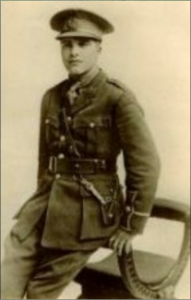
He is remembered on the Tyne Cot Memorial and in 1939 his parents gave a memorial window for the Lady Chapel at Rodborough Church.
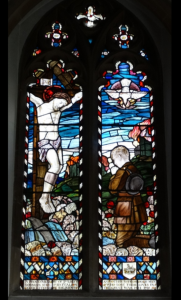
Private Walter Brown also died on 16th August aged 28. He came from a large family at Rooksmoor and as a territorial had been enlisted at the start of the war. He is buried at St Julien Dressing Station Cemetery, Ypres.
Sergeant Richard ‘Dick’ Compton Jackson was severely wounded in the head on August 17th and died on 25th August aged 22. He is buried at Mendinghem Military Cemetery near Poperinge, Belgium. He was an only child from a privileged background, living at Rose Villa (now 169) Bath Rd. He was an apprentice with T.H & J Daniels, when as a territorial he was called up early in the war. He was awarded the Distinguished Conduct Medal posthumously.
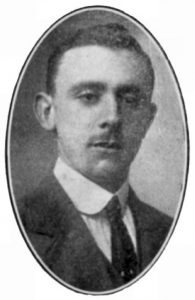
Sergeant Ernest William Chandler, also with 1st /5th Glosters, was injured at St Julien, on an unknown date before 18th September, when his name appears on a casualty list as ‘wounded’. As casualty lists look around a month to be published, it is possible that he too was a casualty of August 16th. He was aged 21 and it seemed that he had proceeded through the casualty clearing system to one of the larger hospitals on route to Le Havre and would have been transferred back to ‘Blighty’, but unexpectedly deteriorated and ‘died of wounds’ in hospital in Rouen. His father had travelled out to Rouen a few days before Ernest’s death on 9th October, but had returned home, believing he would recover.
Ernest attended Kingscourt School and was the eldest of six children of Alf, a ‘tailor presser’ and Mary. They lived in the Little London area of Kingscourt.
Private William Percy Carter served with the Royal Berkshire Regiment and died, aged 33, on 22nd August 1917 in an action recorded as “successful”, though it claimed 230 casualties, 34 of whom were killed. Across the battle front another 1,324 men lost their lives on that day alone. William’s family home was 10 Frome Terrace (now 151 Bath Rd). He had worked as a tailor and outfitter and later as a confectioner and baker. In 1911, he married Clara Alice Phelps and when he died she was living in Acre St, Stroud.
Private Arthur Harris had formerly also been with 1st/5th Glosters and as a territorial, called up in August 1914, when he was only six weeks from completing his apprenticeship with T.H & J Daniels. He lived at 19 Bath Rd Terrace (now 105 Bath Rd).
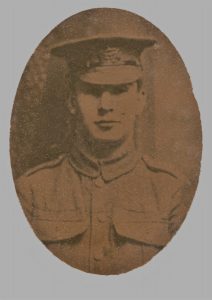
Of all the stories we have researched, his is perhaps the most extraordinary. Serving with the 14th (Service) Battalion, Arthur was listed as “missing in action” on 22nd October 1917, aged 24. Normally this would be the end of the story, but in 1918, in a great act of humanity, a letter in perfect English, was forwarded via the Red Cross from a German soldier, enclosing Arthur’s identity tag as confirmation of his death “in order to spare his relatives useless and painful doubts or hopes”. These items are held in the Soldiers of Gloucestershire Museum in Gloucester.
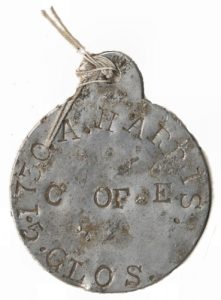
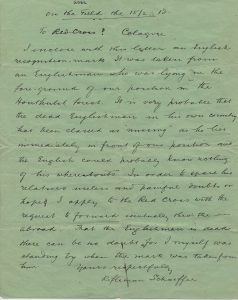
Private Alfred Edward Hollis “Eddie” Spencer served in the 12th (Bristol) Battalion of the Gloucestershire Regiment . He was aged 20 when he died on 7th November 1917. He had lived alongside Wallbridge Mill and was his parents’ only surviving child. His first service number with the Worcestershire Regiment suggests that he was a territorial. His death is a bit of a mystery, as the battalion war diary reports 7th November as a quiet day with no casualties, but his name appears on the Tyne Cot memorial to the missing.
The Battle of Passchendaele was perhaps the most inhumane of all the Great War battles. A senior officer visiting the battlefield afterwards, broke down and declared “Good God. Did we really send men to fight in that!”
